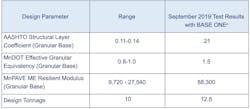Wilkin County, Minnesota Engineer Brian Noetzelman has years of experience with stabilized full depth reclamation (SFDR) projects. The county had a SFDR project scheduled for Wilkin County CSAH #3 in 2019.
In the state of Minnesota counties use a granular equivalency (GE) value when designing roads to help determine the amount of material needed to provide the required strength. The state also requires the county to achieve a specific strength on a road in order to receive state aid funding.
When designing a road 1 in. of MN Class 5 gravel base = 1 GE. The state gives additional credit for stabilized full depth reclamation when blending 50% bituminous pavement and 50% aggregate used in the base layer. Cement or oil emulsions additives provide a GE of 1.5 for every 1 in. stabilized. BASE ONE provides a GE of 1.25 for every 1 in. stabilized. This number system is similar to the structural coefficient numbers many states are familiar with.
The county looked at two options for this 13.2-mile 30-ft.-wide project.
For the first option, the county considered stabilizing 6 in. of base with an engineered emulsion at an estimated cost of $2,375,000. The 6 in. of stabilized 50/50 blend of asphalt and gravel base would provide the needed GE of 9 for this layer. (1.5 GE X 6 in.) = GE of 9 in.
For the second option, the county considered stabilizing 8 in. of base with Team Laboratory Chemical’s BASE ONE at a cost of $223,200. The 8 in. of stabilized 50/50 blend of asphalt and gravel base would provide a GE of 10 which would cover the design for this layer. (1.25 GE X 8 in.) = GE of 10 in.
The second option was selected. To start 4 in. of the existing bituminous surface was milled off. The remaining 4 in. of bituminous and 4 in. of existing aggregate was reclaimed. On the second pass, the tanker truck with the BASE ONE concentrate and water mixture was connected to the reclaimer and the mixture was injected to a depth of 8 in.
The material was compacted with a pad foot roller. The surface was shaped with a motor grader and compacted to density with a rubber-tired roller. The 2.5-in. SP 12.5 non-wearing course mixture (SPNWB230B) was applied. Then a 2-in. SP 12.5 non-wearing course mixture (SPNWB230C) was added. A 1.5-in. SP 9.5 wearing course mixture (SPWEA230C) added to finish the project.
The road was tested in September 2019. American Engineering & Testing Inc. conducted a falling weight deflectometer (FWD) test and used ground penetrating radar to collect data.
The chart below shows the stabilized material exceeded the strength needed to achieve the required design.
For this project, stabilizing 8 in. with the BASE ONE base stabilizer was a great alternative verses stabilizing 6 in. with an oil emulsion. The county saved $2,151,800 on this project.
-------------
Editor's Note: Scranton Gillette Communications and the SGC Infrastructure Group are not liable for the accuracy, efficacy and validity of the claims made in this piece. The views expressed in this content do not reflect the position of the Roads & Bridges' Editorial Team.


